Highlights
from our history
Going from a modest joinery through industrialisation and international expansion. NorDan's more than 90 year old history holds both peaks and troughs on the road to the company we know today.
1919
Johannes Rasmussen, a 23-year-old newly qualified wheelwright from Denmark, travels to Stavanger to find work while waiting for a visa to the US. He finds work at Byggmester Karl Sunde and is promoted to foreman at the age of 25.
1922
Johannes arrives in Moi on a construction assignment. Gets to know Tøri Tonette Skjeggestad.
1925
Builds a house before they marry. Has three sons, Nils in 1926, Leif in 1929 and Kåre in 1932. All work their entire careers in the company.
1926
Buys the neighbouring property from Gustav Eriksen and furnishes a 28 sqm workshop. Fjældhammer Trævarefabrik. Manufactures windows, doors, stairs and other items in the workshop for his building projects and sells to other builders, something unusual in the industry at the time.
1929
Demolishes the workshop building and builds a new two-storey building. 78 square metres. Constructs own production machinery.
1933
25 men employed. Building houses from Jæren to Lista. Very low material prices in these years.
1936
The price of timber is up 40%, but that doesn't stop construction, because times are better now.
1939
Starting on the most complicated house yet, a new medical centre in Moi. Has built around a hundred houses since 1925.
1940
The outbreak of the Second World War. Housing construction is halted. Rasmussen reduces to a couple of men so as not to have to work for the German occupiers.
1942
His son Nils and Levi Larsen begin mass production of wooden combs. Johannes is involved in making the machines. Eventually, 10 people have permanent employment.
1943
Johannes Rasmussen arrested for ten days because he failed to accept work for the Germans. He is detained in Stavanger together with several Lunddølers.
1945
The war ends. No one buys wooden combs, and Nils makes wooden toys without selling enough to make a living. Returns to house building, but materials are strictly rationed.
1947
His son Leif takes over the office work that Johannes had neglected.
1950
After attending a secondary and business school in the USA for two years, Kåre began working for his father in 1954.
1953
Using own staff, a new workshop and timber warehouse is erected between the river and the railway. Continues construction, and after a couple of years reaches 1,000 square metres in total.
1956
With diligent effort, manages to produce 365 windows, an average of one per day.
1957
Johs. Rasmussen & Sønner new company name. The «Nor-Dan Sving» window is in production. Produces 1600 within a few years. Significant construction projects in 1957-58: Kiellands Minde school and new old people's home at Moi.
1958
Kåre returns home after completing technical vocational school and a vocational certificate. Takes over as General Manager.
1960
Establishes Johs. Rasmussen A/S with the father and three sons as owners. Johannes and Kåre spend most of their time constructing a brand-new window. Revenues reach NOK 1 million, with an operating profit of zero. They have very little to invest in product development. The average annual salary in Norway at the same is just under NOK 10,000.
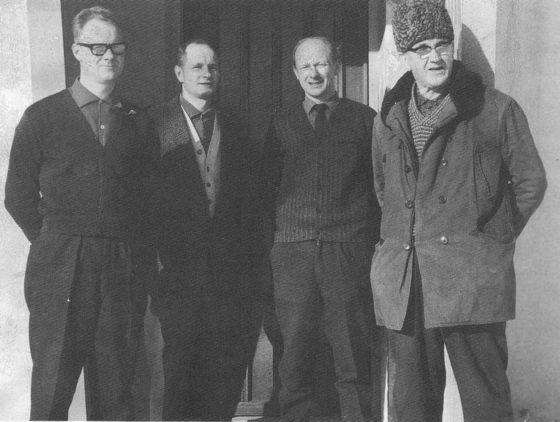
1961
Bygger selv en del arbeidsbesparende maskiner, bl.a. for montering av beslag og laging av espagnoletter med bolter.
1962
The prototype of Nor-Dan Perfekt is completed. Patents the mechanism with an embedded half-ball bearing in the corner. Produces 700 the first year. Nils Rasmussen starts travelling to sell windows. Largest order to Porsgrunn: 396 windows.
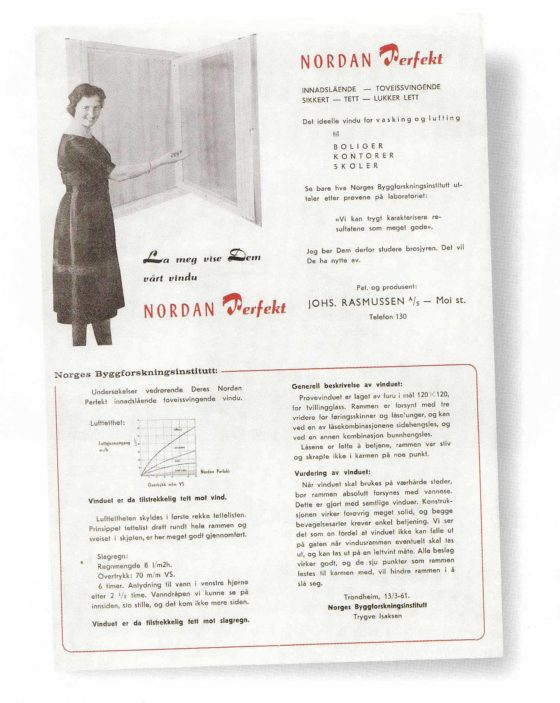
1964
First contact with G. Block Watne. Later becomes a large and long-term individual customer.
1967
Starts building the large factory halls along the river, each measuring 1,600 square metres. Ten halls in ten years. Kåre Rasmussen draws up a sketch of future development, and it is largely followed until 2001. The first district office and dealer is established, Eriksen Agentur A/S in Kristiansand.
1969
Production passes 50,000 windows. Kåre travels to Iceland to learn how to make insulating glass units.
1970
Number of employees increases to 168, revenue reaches 20 million NOK, up from one million NOK ten years earlier. Produces 70,000 windows. Establishes own production of insulating glass on the 2nd floor of an old factory hall.
1971
Major reorganisation of production. Oslo office in Grefsen with Bjørn Pedersen established. Own element factory for G. Block Watne, producing elements (framework for walls with windows installed) active until 1990.
1972
More than 200 employees, turnover close to 40 million, doubling in two years. Strong inflation. Just over 100,000 windows, a large number of new machines. Enrolls in an inspection programme by the Norwegian Building Research Institute. Insulating glass production in new premises. The King's Medal of Merit is awarded to Johannes Rasmussen.
1973
Gori-Vac impregnation plant commissioned. Builds insulating glass factory. The district office in Trondheim is established by Thor Kårstad.
1974
Revenue close to NOK 60 million. Acquires A/S Vinduselement's factory in Otta and converts it to the production of NorDan windows.
1975
Revenue of NOK 80 million, with more than 300 employees. Otta in addition with 10 million. A total of 190,000 windows. District offices in Stavanger and Bergen established. New office building 1600 square metres at Moi erected by the construction department.
1976
Revenue of NOK 100 million and record profits. 50th anniversary with a public celebration. Awarded "Company of the Year".
1977
214,000 units produced. The sales increase is formidable, so NorDan has a six-month delivery time for most products. The company is awarded "Marketer of the Year".
1978
Revenue up 22%. New impregnation plant, new building for product development. Johannes Rasmussen awarded "Knight of the 1st Class Order of St Olav", presented at his and Tøri's 55th anniversary.
1979
Revenue exceeds NOK 150 million, of which 30 at Otta. Over 400 employees at Moi, 79 at Otta. 270,000 units. Johannes Rasmussen died on 18 April.
1980
Decline in housing construction, number of employees slightly down. New factory halls of 3600 square metres. Increase in revenue and market share.
1981
Number of windows down 40,000 to 140,000 at Moi, at Otta down 13,000 to approx. 70,000. Increased sales at the end of the year. More than half of the glass is triple-glazed.
1982
Revenue of NOK 180 million, again close to 400 employees. Acquires the bankruptcy estate of Asbjørn Ege A/S in Egersund, the country's largest door factory.
1983
530 employees in the Group. Increased window production to 160,000 at Moi. 62,000 unchanged at Otta. Major investments in Egersund.
1984
For the first time since 1960, revenue decreased by NOK 4.2 million to NOK 207 million.
1985
Progress. Revenue up 20 million at Moi. Exports doubled to almost 14 million. A new sliding door from Egersund increases sales by 41%.
1986
60th anniversary with public celebration at Moi. Transition to double-glazed energy glass. Revenue up 14%. Invests NOK 15 million in new machinery. New facilities in Oslo celebrated in October. Tøri Tonette Rasmussen died on 4 December.
1987
Sales and exports up. The three-handled tilt-and-turn ND windows improved on 18 points after customer survey.
1988
Strong year despite the crisis in the construction industry. Revenue of 328 million, profit of 27 million. Supplies 5000 windows to Amsterdam. Acquires majority shareholding in English import company. Many domestic bankruptcies. Named company of the year by local newspaper Dalane Tidende.
1989
Barely makes a profit. Housing construction in Norway cut in half in two years, large buildings halved in one year. ND exports increase 140% to NOK 65 million, mostly to Sweden and the UK. Insulating glass production is a success. Discontinues the construction department, retains half the department in the maintenance department, the rest to the window factory. Acquires Eriksen Agentur in Kristiansand. Receives the Lund Municipality Culture Prize for the NorDan indoor sports centre.
1990
Sales of windows halved in Norway in the period 1987-92. NorDan is still in full production, taking all kinds of orders. Full price war.
1991
Worst construction year since the war, but saved by the fact that 1/3 of sales are exports. Establishes NorDan Nederland BV. Invests in Germany. Receives ISO certificate as the first wood products factory in Norway. Awarded "The Golden Saw Blade". Johannes Rasmussen takes over as Sales Director from Nils Rasmussen.
1992
Exports account for 36% of sales. Change of CEO, Tore Rasmussen takes over from Kåre Rasmussen. Wins prestigious Swedish competition for "Supervinduet". Recognised and praised by the Norwegian Export Council in the UK. Own company in Berlin.
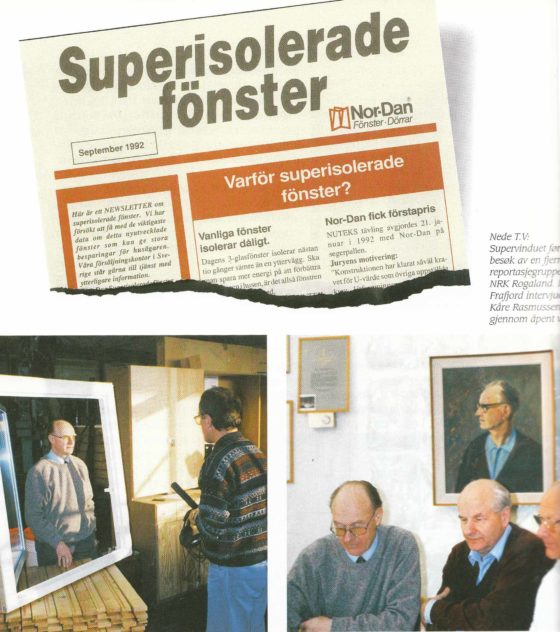
1993
Record sales of NOK 350 million. Loses NOK 5 million on the bankruptcy of Hetland Hus and Swedish devaluation, but earns this back through reduced costs. Research Council of Norway Effort Award to Kåre Rasmussen, Export Council of Norway's Netherlands Office Award to Bruin Steur.
1994
Acquires Nyseter Trevarefabrikk, which becomes Johs. Rasmussen Arneberg A/S, 72 employees. Over 700 employees in the group. Acquires the factory facility at Otta from the municipality, 20 years after the purchase of the factory itself. Receives the "Norwegian Award for Productivity". Market share increased from 14% to 22% in a few years. 50 sales staff in other countries, 2/3 of exports go to the UK. Marketing manager Karl Melkeraaen dies. Jan O. Eriksen takes over.
1995
Significant progress at an expanded Oslo office. Kåre Rasmussen appointed Knight 1st Class of the Royal Norwegian Order of St Olav for services to Norwegian industry.
1996
Insulating glass unit no. 5 million celebrated. Significant order to Russia results in an export increase of 100 million. NorDan museum opened. Celebrates 70th anniversary.
1997
Market share 25%. Productivity increase 10%. The Window & Door book is launched, marketing the NorDan Spar Standard. Received award from Nordbohus as best supplier.
1998
Divides the business in an operating and a property company. NorDan AS name of the operating company. Record profit of NOK 22 million, group revenue of NOK 560 million. Manufactures 320,000 insulating glass panes. Success for the Villa window at Arneberg. The Euro window produced by the factory is on its way out. Receives supplier of the year award from Hellvik Hus.
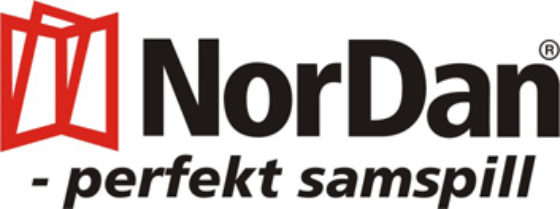
1999
25-30% larger order backlog than before. Otta's 25th anniversary. Arneberg good quality and delivery reliability.
2000
Revenue of 643 million and profit of 30 million for the group. 871 employees. 133 more than five years ago. Exit from Germany, new management and market policy in the Netherlands. Acquires Bordörren in Sweden. ISO certificate for Arneberg. Otta takes over Toppsving production entirely from Moi. Minister of Trade and Industry, Grethe Knutsen, unveiled founder Johannes Rasmussen's statue outside the town hall on 15 August. The last train leaves the Moi and Otta factories as the side tracks are closed.
2001
850 employees in 5 factories and sales offices in Norway and several countries. A new window book is produced and NorDan celebrates its 75th anniversary.
2005
NorDan AS acquires Tanum Fönster in Sweden.
2007
NorDan launches NTech. First Nordic Swan Ecolabelled window in Norway. Referred to as "A world-class window". Sales success. Establishes NorDan AB in Sweden.
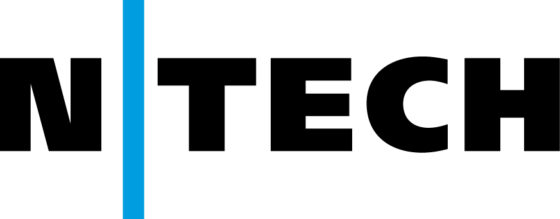
2008
Great success with Low Energy Window with insulated frame and Passive Window with insulated frame and sash. Norwegian Wood competition in Stavanger with a focus on energy saving. NorDan gets almost all the projects and is the only manufacturer with a Passive Window in production.
2009
Passive balcony door presented at the Bygg Reis Deg trade show. Also launches NorDan VIS. New building regulations recommend that windows should be further into the wall.
2010
NTech becomes standard for all windows. Divided into NTech 1.2 / NTech 1.0 and NTech 0.7 Passive. Launches new window book. Focus on energy savings and being environmentally friendly. Supplier of the year at Systemhus.
2011
Acquires Kvillsfors Fönster in Sweden. At Bygg Reis Deg, NorDan showcases a prototype of the NorDan active motorised window and solar collector.
2013
NorDan delivers its first order for a project in China. Also signs a co-operation agreement with Lyse and establishes the Smart project. The world's first SmartDoor is presented at Bygg Reis Deg.
2014
NorDan closes the factory at Arneberg. The customer promise is introduced in the Norwegian market and NorDan acquires a majority stake in ID Lock.
2015
NorDan acquires a majority stake in Byggevareleverandørene AS. Dramatic flooding hits the factory in Moi, and NorDan opens a new factory in Powodowo.
2016
NorDan celebrates its 90th anniversary. Aluminium production at Moi is discontinued, and the newly built factory in Powodowo, Poland, takes over the production and powder coating of aluminium for all the factories.
2017
NorDan AS is named "Supplier of the Year" five times. At the beginning of 2018, a new group structure is established, with NorDan AS in Norway, NorDan AB in Sweden and NorDan UK Ltd. in the UK as the most important companies. The group consists of a total of 25 sales offices and 10 factories.
2018
A new corporate structure is established with NorDan Gruppen AS as the parent company.
2019
Starts production of all-aluminium door and window solutions.
2020
Acquires the majority shareholding in Danish STM Vinduer A/S, thus completing the circle that began in 1919. Also acquires the sales company NorDan Vinduer Ltd. in Ireland, which through close co-operation has supplied NorDan products to the Irish market for a number of years. NorDan AS acquires the majority shareholding in the façade supplier Rubicon in Rogaland.